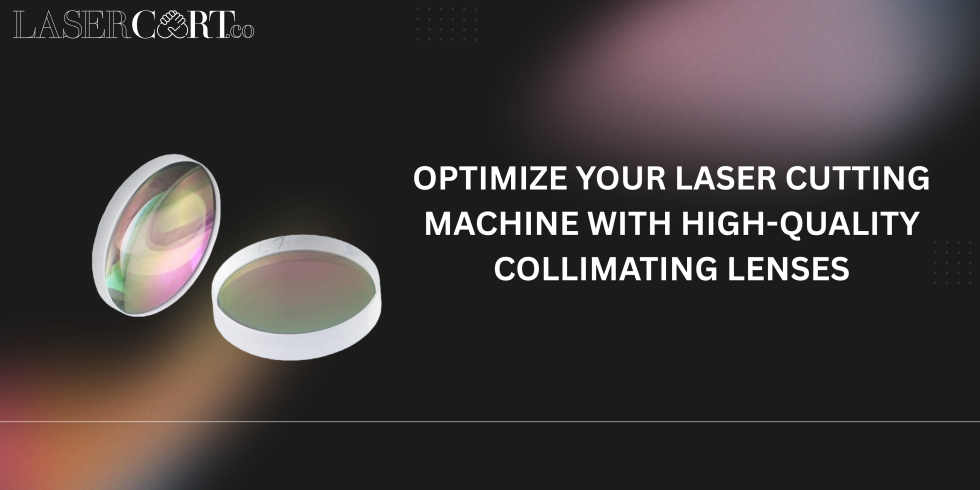
Introduction
Laser cutting machines are all about precision, speed, and performance. But did you know that one small component — the collimating lens — plays a huge role in determining how well your machine performs? Yep, that tiny piece of glass is actually a game-changer. Let’s dive into how you can unlock next-level laser cutting by optimizing with high-quality collimating lenses.
What Are Collimating Lenses?
A collimating lens takes scattered light and straightens it into a parallel beam. This step is essential in laser systems because it ensures that the laser beam maintains its power and focus when hitting the material. Without proper collimation, your beam could spread or weaken before it even makes contact.
How Do Collimating Lenses Work in Laser Machines?
Inside your laser cutting machine, the laser beam first passes through a collimating lens that aligns the beam into a parallel ray. This beam is then sent through a focusing lens that sharpens it into a precise point. This process determines how clean, deep, and accurate your cuts will be.
Collimation vs. Focusing – What’s the Difference?
Think of collimation as aiming a flashlight in a straight beam, and focusing as zooming it into a laser pointer. Both are essential, but collimation sets the foundation for beam quality.
Importance of Collimating Lenses in Laser Cutting
Enhancing Beam Quality
Without a good collimating lens, the laser beam loses its shape. That leads to inconsistent performance and poor edge quality.
Improving Cutting Accuracy
A well-collimated beam ensures precise cuts, especially on detailed or delicate designs.
Reducing Material Waste
Clean cuts mean fewer errors and less scrap, saving you both time and money.
Types of Collimating Lenses
Fused Silica Lenses
These are durable and ideal for high-powered lasers due to their thermal resistance.
ZnSe (Zinc Selenide) Lenses
Popular in CO₂ lasers, ZnSe lenses offer excellent transmission and low absorption.
Coated vs. Uncoated Lenses
AR-coated lenses reduce reflection and improve efficiency, while uncoated lenses are cheaper but less durable.
Factors to Consider When Choosing Collimating Lenses
Beam Diameter and Focal Length
Matching the lens to your beam size and desired focal point is crucial for performance.
Laser Power Compatibility
Not all lenses can handle high-watt lasers. Using the wrong one can damage the lens or machine.
Lens Material and Coating
Choose materials that can withstand heat and offer high transmission with minimal reflection.
Signs You Need to Replace Your Collimating Lens
- Scratches or cracks on the surface
- Noticeable drop in cutting precision
- Beam appears weak or misaligned
Don’t wait for a total failure — regular inspections can save your machine and projects.
Benefits of Using High-Quality Collimating Lenses
Extended Machine Life
Quality lenses reduce wear and tear on the machine’s internal components.
Enhanced Productivity
Sharper cuts and faster speeds boost your workflow efficiency.
Lower Maintenance Costs
High-grade lenses last longer and require fewer replacements.
Where to Buy Quality Collimating Lenses
Trusted Suppliers and Online Platforms
Go for reliable names with customer support, genuine parts, and warranty options.
Why Lasercart.co is a Reliable Source
Lasercart.co offers a wide range of authentic laser cutting parts, including premium collimating lenses, with doorstep delivery and dedicated customer service.
Proper Maintenance of Collimating Lenses
Cleaning Procedures and Tools
Use lens cleaning solution, lint-free wipes, and anti-static brushes.
Storage Best Practices
Keep lenses in anti-dust cases away from moisture and direct sunlight.
Routine Inspection Tips
Check weekly for smudges, burns, or misalignment.
Installation Guide for Collimating Lenses
Safety First
Turn off the machine, wear gloves, and handle lenses with care.
Step-by-Step Installation
- Remove the old lens carefully
- Insert the new lens using proper orientation
- Tighten screws gently without overpressure
Alignment and Testing
After installation, test for beam alignment using a test sheet or calibration tool.
Real-Life Industry Applications
Sheet Metal Fabrication
Clean cuts on steel, aluminum, and other metals.
Automotive Industry
Precision parts and body components.
Aerospace and Electronics
Cutting intricate shapes for lightweight parts and PCBs.
Common Mistakes to Avoid
- Using generic or low-quality lenses
- Forgetting regular lens cleaning
- Rushing the installation process
Even small errors can lead to major performance drops.
Innovations in Collimating Lens Technology
Anti-Reflective Coatings
Minimizes light loss and improves beam transmission.
Smart Lens Systems
Auto-adjusting lenses adapt to different materials and tasks.
Integration with AI and IoT
Real-time lens monitoring for predictive maintenance and performance tracking.
Expert Tips for Optimizing Laser Performance
- Keep a spare lens ready
- Clean your lens weekly
- Match lens specs to your cutting task
- Use only verified replacement parts
Conclusion
When it comes to laser cutting, the details matter — and your collimating lens is one of the most critical components in the entire system. Investing in high-quality collimating lenses not only improves cut precision and reduces downtime but also protects your overall machine investment. Whether you’re slicing through sheet metal or crafting intricate patterns, the right lens makes all the difference.
FAQs
Q1: How often should I replace my collimating lens?
A: Generally, every 3–6 months depending on usage, but inspect regularly for signs of wear.
Q2: Can I clean the lens myself?
A: Yes, with proper tools and caution. Always follow safety procedures.
Q3: What’s the best lens material for fiber lasers?
A: Fused silica is often preferred for its durability and thermal stability.
Q4: Are all collimating lenses compatible with any laser machine?
A: No. Always check your machine’s specifications before purchasing.
Q5: Where can I buy genuine collimating lenses online?
A: Lasercart.co is a trusted platform for authentic, high-quality laser cutting spare parts.










